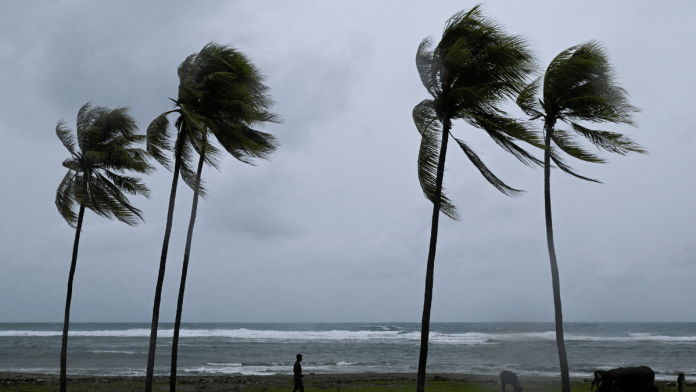Kingston: Hurricane Melissa churned north-east toward Cuba’s second-largest city on Tuesday as a powerful Category 4 storm, hours after making landfall in nearby Jamaica as the strongest-ever storm to hit the Caribbean island nation.
Melissa struck land near Jamaica’s southwestern town of New Hope, packing maximum sustained winds of 185 mph (295 kph), the U.S. National Hurricane Center said in an advisory, well above the minimum strength of a Category 5 storm, the most powerful level on the Saffir-Simpson scale.
In southwestern Jamaica, the parish of St. Elizabeth was left “underwater,” an official said, and over half a million residents were without power.
By 2100 GMT, Melissa had weakened to 145 mph (233 kph), the NHC said, as it moved past the mountainous island, where highland communities are vulnerable to landslides and flooding.
It is now forecast to curve toward Santiago de Cuba, Cuba’s second-largest city.
“We should already be feeling its main influence this afternoon and evening,” Cuban President Miguel Diaz-Canel said in a message published in state newspaper Granma, in which he called on citizens to heed evacuation orders.
“There will be a lot of work to do. We know that this cyclone will cause significant damage.”
Cuban authorities said they evacuated about 500,000 people. In the Bahamas, next in Melissa’s crosshairs, the government ordered further evacuations for people living in southern parts of the archipelago.
Nearby Haiti and the Dominican Republic have faced days of torrential downpours leading to at least four deaths, authorities there said.
Local media reported at least three deaths in Jamaica during storm preparations, and a disaster coordinator suffered a stroke while carrying out her duties in the onset of the storm and was rushed to hospital. Late Tuesday, many areas remained cut off.
JAMAICA’S ‘STORM OF THE CENTURY’
No stranger to hurricanes, Jamaica had never before taken a direct hit from a Category 4 or 5 storm.
The Jamaican government called for foreign aid as it prepared for the fallout of the strongest-ever storm to directly strike its shores.
Meteorologists at AccuWeather said Melissa was the third most intense hurricane observed in the Caribbean after Wilma in 2005 and Gilbert in 1988 – the last major storm to make landfall in Jamaica.
“It’s a catastrophic situation,” the World Meteorological Organization’s tropical cyclone specialist Anne-Claire Fontan told a press briefing, warning of storm surges up to four meters high. “For Jamaica, it will be the storm of the century for sure.”
Colin Bogle, an adviser to aid group Mercy Corps in Portmore, near Jamaica’s capital of Kingston, said he had heard a loud explosion in the morning, and then everything went dark. Sheltering with his grandmother, he heard relentless noise and saw trees violently tossed in the wind.
“People are scared. Memories of Hurricane Gilbert run deep, and there is frustration that Jamaica continues to face the worst consequences of a climate crisis we did not cause,” he said.
Scientists warn that storms are intensifying faster as a result of climate change warming ocean waters. Many Caribbean leaders have called on wealthy, heavy-polluting nations to provide reparations in the form of aid or debt relief.
Melissa’s size and strength ballooned as it moved over unusually tepid Caribbean waters, but forecasters warned that its slow movement could prove particularly destructive.
Food aid will be critical, Bogle said, as well as tools, vehicle parts and seeds for farmers. Like last year’s devastating Hurricane Beryl, Melissa crossed over some of Jamaica’s most productive agricultural zones.
On Monday, Jamaican Prime Minister Andrew Holness said the government had an emergency budget of $33 million and insurance and credit provisions for damage a little greater than Beryl.
‘LIKE A ROARING LION’
Melissa made landfall in southwestern Jamaica, near the parish border between Westmoreland and St. Elizabeth, which was one of the areas worst-hit by Hurricane Beryl last year.
Authorities reported severe damages to public infrastructure including hospitals, and said that as of 4 p.m. (2100 GMT), over half a million residents were without power.
St. Elizabeth was “underwater”, local government minister Desmond McKenzie told a press briefing. Its only public hospital lost power and reported severe damage to one of its buildings, and several families were marooned in their homes.
Rescue teams were struggling to reach stranded families, McKenzie added, but had managed to reach one group marooned with four babies.
In Portland Cottage, some 150 km (94 miles) away from where Melissa made landfall, 64-year-old retiree Collin Henry McDonald told Reuters as the storm advanced that his community was seeing strong rain and winds, but his concrete roof was holding steady.
“It’s like a roaring lion. It’s mad. Really mad,” he said.
Around 15,000 Jamaicans were in temporary shelters by late Tuesday, McKenzie said. The government had issued mandatory evacuation orders for 28,000 people, but many were reluctant to leave their homes.
The International Federation of the Red Cross said up to 1.5 million people in Jamaica were expected to be directly affected by the storm.
The NHC advised Jamaicans to remain in shelter overnight as winds and rains continue to batter the island.
(Reporting by Zahra Burton in Kingston, Sarah Morland and Brendan O’Boyle in Mexico City, Dave Sherwood in Havana, David Ljunggren in Ottawa, Emma Farge in Geneva and Ashitha Shivaprasad in Bengaluru, Harold Isaac in Montreal; Editing by Ros Russell, Rod Nickel, Aurora Ellis and Leslie Adler)
Disclaimer: This report is auto generated from the Reuters news service. ThePrint holds no responsibility for its content.






